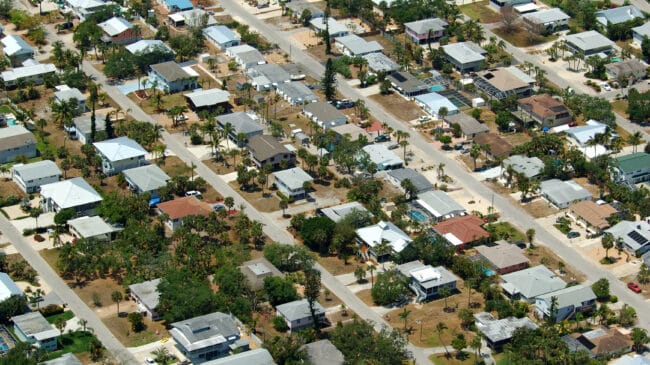The national median home price has surged by over 80% since the end of the Great Recession. In just the last year, home prices have risen by 20 percent—even outpacing the relatively high rate of inflation. This rapid growth, combined with economic stress brought on by the COVID-19 pandemic, has rightfully drawn more attention to housing affordability.
Several factors are responsible for rising home prices, some of which are out of the control of policymakers and some of which are a direct result of policies adopted by state and local governments. Land-use regulations, building codes, permitting, taxes, and fees are all ways that government policy can affect the cost of housing.
Impact fees, for example, can add to the cost of housing in ways that are often regressive. Impact fees are regulatory fees imposed by local governments to offset the cost of infrastructure investments necessary to accommodate new development. Impact fees are typically charged for infrastructure and services including roads, fire and emergency medical services, schools, parks, water, and wastewater. When properly designed and implemented, impact fees act as user fees that raise money directly from those who benefit from the infrastructure and services funded by the fees.
Importantly, impact fees can offset other fees and taxes, such as property taxes.
This can alleviate existing property owners of the burden of providing public goods and services for new development. To the extent that existing property owners do not have to pay for the fees, they may be less inclined to oppose new development. In this way, impact fees may serve as a bulwark against more exclusionary land-use policies. As urban economist William Fischel notes in his book The Homevoter Hypothesis, impact fees may be a way to circumvent moratoriums on new development. Economic research on the subject suggests that impact fees result in increased housing construction.
Impact fees can be efficient when they accurately reflect the marginal cost of development to local governments. Unfortunately, impact fees are often poorly designed or used for purposes that are not directly related to the impact of new development. They are are also sometimes used as a source of funding for services more appropriately funded through other channels.
Many municipalities impose flat fees that are not adjusted to the size or impact of individual housing units. This can be appropriate in cases where the impact of new development is the same for every home. But in cases where the impact of development is related to the size or features of a home, flat fees are highly regressive. For example, Lee County, Florida imposes a roads impact fee of $9,996 for all single-family homes. Table 1 shows the relative cost of this fee on three hypothetical houses. A flat fee of $9,996 accounts for 5.6% of the sales price of a $180,000 home compared to 3.7% of a $270,000 home and just 2.8% of a larger $360,000 home. This disparity implies that flat impact fees are regressive in that they disproportionately impact low-income homebuyers.
| TABLE 1. EQUITY EFFECTS OF ROADS IMPACT FEES IN LEE COUNTY, FL | |||
| House A | House B | House C | |
| Sales Price | $180,000 | $270,000 | $360,000 |
| Home Size (Sq. Ft.) | 1,200 | 1,800 | 2,400 |
| Roads Impact Fee | $9,996 | $9,996 | $9,996 |
| Roads Fee as a Share of Sales Price | 5.6% | 3.7% | 2.8% |
Source: Lee County Land Development Code Sec. 2-266.
By contrast, transportation impact fees in Orange County, Florida are scaled to the square footage of single-family homes. This approach is less regressive and reflects the greater impact that larger homes would likely have on transportation infrastructure. Table 2 shows the relative cost of this fee structure on the same three hypothetical homes. The transportation impact fee accounts for 4.4% of the sales price of House A, 3.8% of House B, and 3.5% for House C. While still slightly regressive, the fee structure used in Orange County is more equitable than the flat fee used in Lee County.
| TABLE 1. EQUITY EFFECTS OF ROADS IMPACT FEES IN ORANGE COUNTY, FL | |||
| House A | House B | House C | |
| Sales Price | $180,000 | $270,000 | $360,000 |
| Home Size (Sq. Ft.) | 1,200 | 1,800 | 2,400 |
| Transportation Impact Fee | $7,973 | $10,138 | $12,509 |
| Transportation Fee as a Share of Sales Price | 4.4% | 3.8% | 3.5% |
Source: Orange County Code Sec. 23-92.
Scaling impact fees to the square footage of homes is just one possible approach to making them less regressive. Other municipalities consider the number of bedrooms. For water and wastewater impact fees, the number and types of water fixtures could be used to calculate impact fees. Regardless, the objective should be to develop fee schedules that reflect the relative impact of development without being overly complicated.
As a practical matter, municipalities should strive to make impact fees transparent and predictable. Fee schedules that are easy to understand, easy to access, and relatively stable allow developers to plan future projects by reducing uncertainty. This would facilitate additional construction, increasing the supply of housing and reducing costs.
Municipalities could also reduce uncertainty by locking in impact fees at the time when permit applications are submitted. Lengthy permitting delays are already costly to developers but can result in further uncertainty if impact fees are only assessed at the time of permit approval. Builders often use loans to buy land and building materials, and the payments on those loans need to be made regardless of whether construction is occurring. Those added costs are passed on to buyers in the form of higher home prices.
Impact fees can raise housing prices in ways that are often regressive. However, they can also facilitate development when properly designed and implemented. While impact fees are far from the only factor affecting home prices, they should not be ignored by policymakers concerned about housing affordability.

